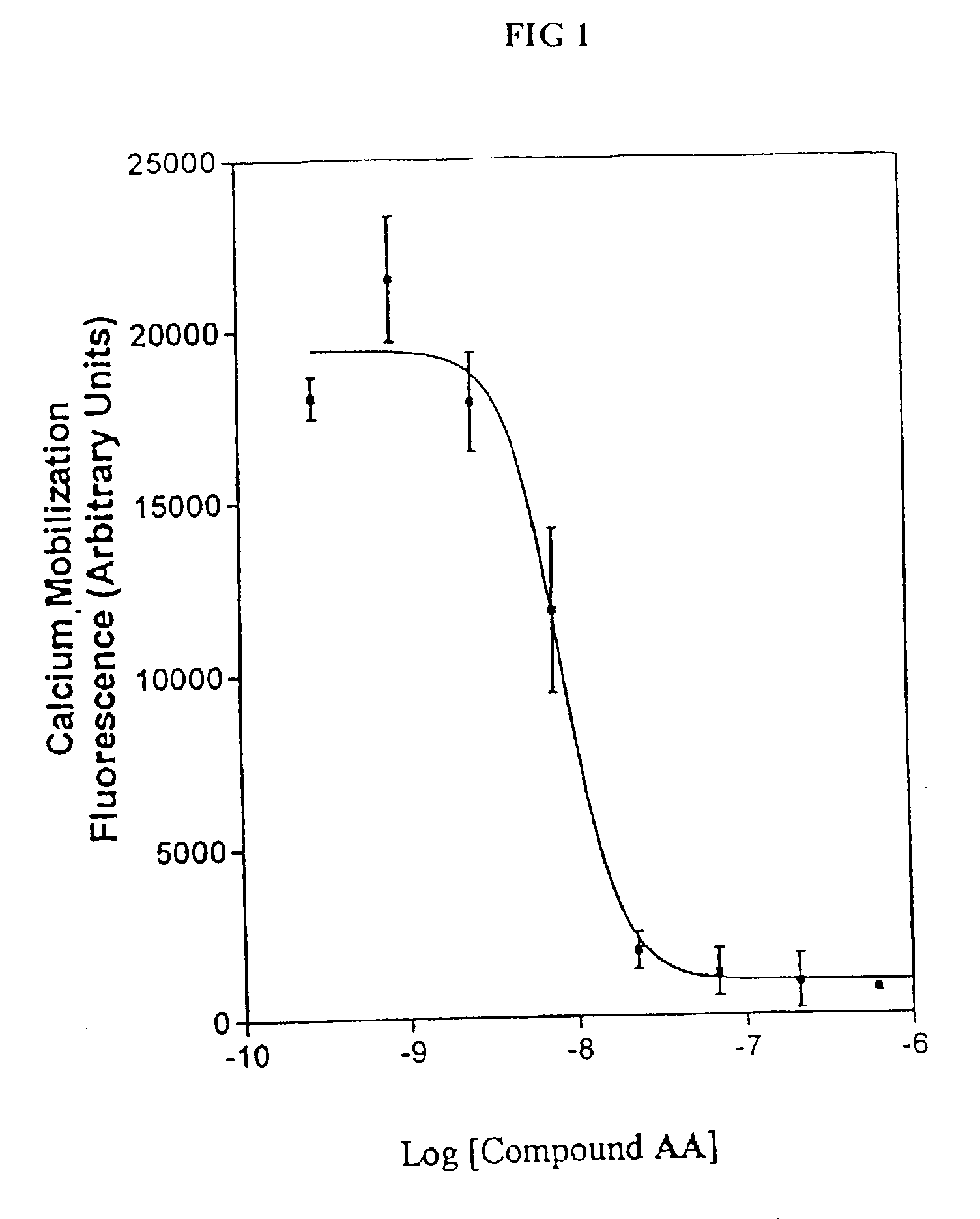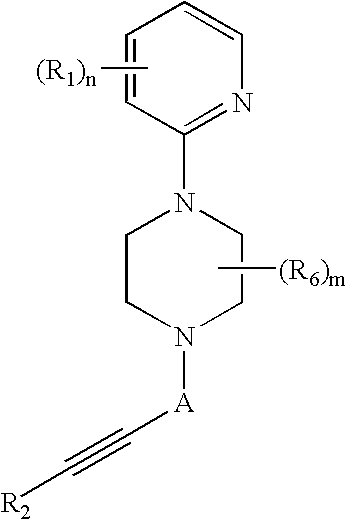Therapeutic agents useful for treating pain
a technology of therapeutic agents and compounds, applied in the field of piperazine compounds, can solve the problems of drug ineffectiveness, high cost of ui, and over $15 billion in health care costs associated with ui
- Summary
- Abstract
- Description
- Claims
- Application Information
AI Technical Summary
Benefits of technology
Problems solved by technology
Method used
Image
Examples
examples 1-68
relate to the synthesis of illustrative Piperazine Compounds.
example 1
6.1 Example 1
Synthesis of Compound AA
A solution of 2-chloro-3-nitropyridine E (4.2 g, 27 mmol) (commercially available from Aldrich Chemical Co., Milwaukee, Wis.), t-butyl 1-piperazinecarboxylate F (5.0 g, 27 mmol), and triethylamine (“TEA”) (10 mL) in CH2Cl2 (200 mL) was stirred at room temperature for 4 h. The solution was then extracted with water, the organic layer separated and dried (Na2SO4), and the organic solvent removed under reduced pressure to provide compound G. Liquid chromatography—mass spectral (“LCMS”) analysis showed 100% conversion to compound G. Compound G was redissolved in CH2Cl2 (150 mL) and the resulting solution cooled to 0° C. Trifluoroacetic acid (“TFA”) (60 mL) was then slowly added to the solution and the resulting mixture allowed to stir overnight at room temperature. The solution was then evaporated to dryness to afford 1-(3-nitro-pyridin-2-yl)-piperazine, compound H, as yellow powder. Compound H was used in final step C without further purification.
P...
example 2
6.2 Example 2
Synthesis of Compound AB
To a mixture of compound K (1.2 mmol) (made from the reaction of 2-chloro-3-cyanopyridine and t-butyl 1-piperazinecarboxylate, compound F, according to the method of Step A in Example 1) and PCl5 (1.2 mmol) in 5 mL of dichloroethane was added, in one portion, 1 mmol (1 eq.) of compound I and 2 eq. of diisopropylethylamine (“DIEA”) and the resulting reaction mixture was allowed to stir at 40° C. for 2 h. Thin-layer chromatography demonstrated the complete disappearance of compound K. 5 mL of aqueous NaOH (1 N) was added to the reaction mixture and the organic layer separated. The aqueous layer was then extracted with ethyl acetate (3 mL, 2 times) and the organic layers combined, dried (potassium carbonate), and the solvent removed under reduced pressure to provide a brown oil. The resulting brown oil was dissolved in 1 mL of dichloromethane (“DCM”) and purified by column chromatography on a silica column (5 g silica). The column was eluted by grad...
PUM
| Property | Measurement | Unit |
|---|---|---|
| physical health | aaaaa | aaaaa |
| physical | aaaaa | aaaaa |
| tension | aaaaa | aaaaa |
Abstract
Description
Claims
Application Information
 Login to View More
Login to View More - R&D
- Intellectual Property
- Life Sciences
- Materials
- Tech Scout
- Unparalleled Data Quality
- Higher Quality Content
- 60% Fewer Hallucinations
Browse by: Latest US Patents, China's latest patents, Technical Efficacy Thesaurus, Application Domain, Technology Topic, Popular Technical Reports.
© 2025 PatSnap. All rights reserved.Legal|Privacy policy|Modern Slavery Act Transparency Statement|Sitemap|About US| Contact US: help@patsnap.com



